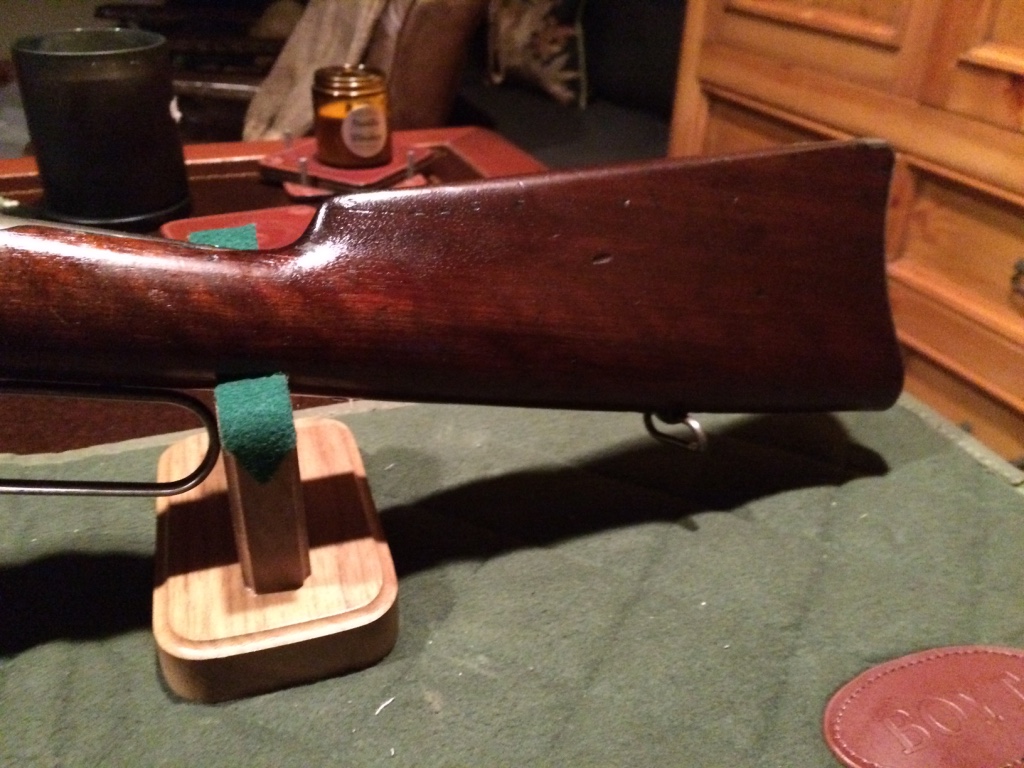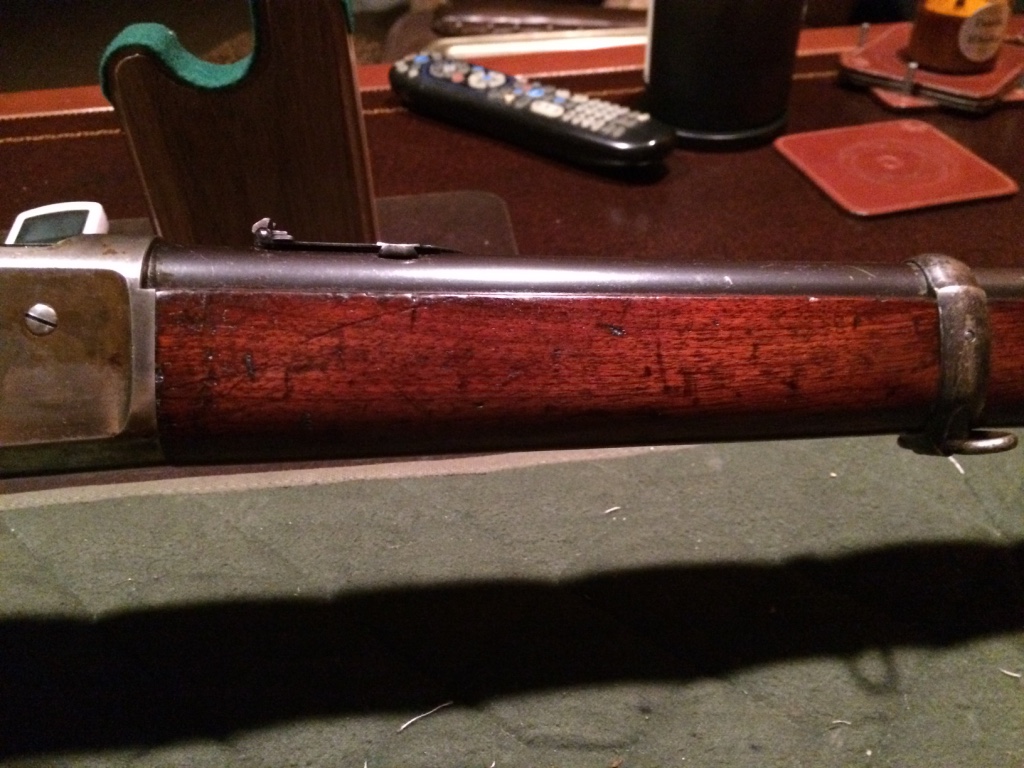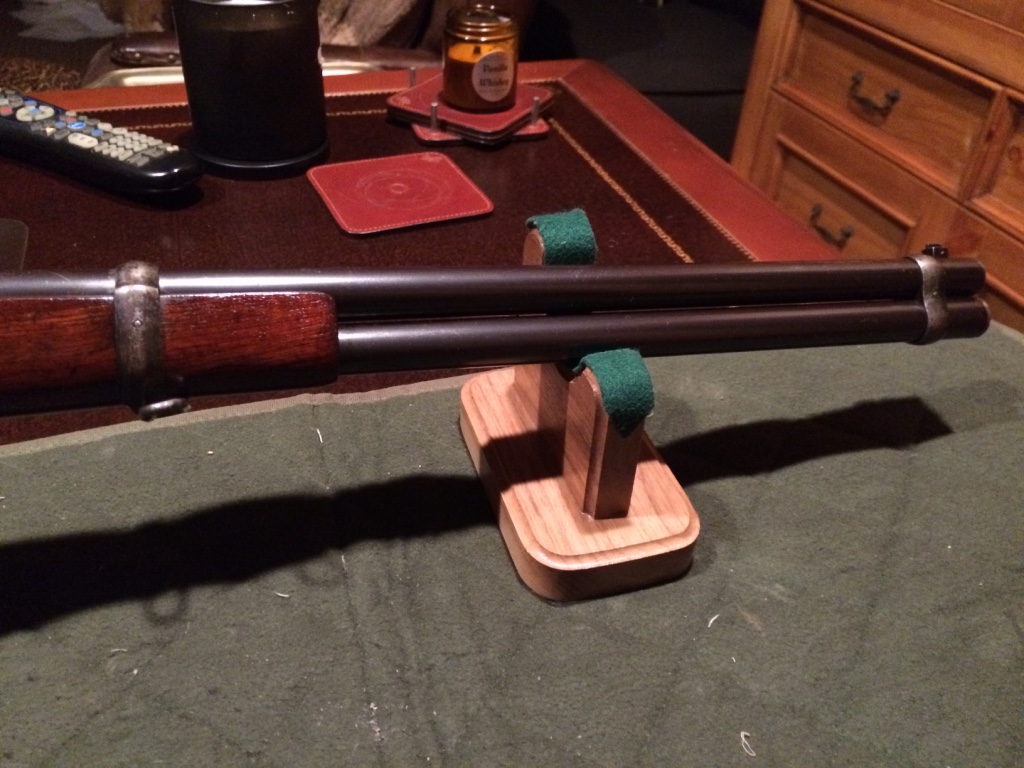Larry,
I do not have one with factory sling eyes that I can go measure. What I can tell you, is that Winchester installed them at least 6+ inches from the toe of the butt plate. Most of them that I have seen that were installed aftermarket, are located too close the toe of the butt stock.
If the sling eyes are not mentioned in the warehouse ledger (on a factory letter), 98% of the time they were installed after the fact.
Bert
WACA Historian & Board of Director Member #6571L

I have a Winchester 1894 Rifle dating from the 23rd of May 1918, this rifle being in .30 WCF. This rifle has factory original swivels that were viewed in a photograph by Bert as being factory original. The distance from the toe of the butt to the centre of the swivel is approximately 2 11/16″. This means that, for this particular rifle, the sling swivels were installed at the aforementioned (atypical) location, OR that factory original swivels were installed at a later date at a location that was not identical to most, or all factory-installed swivels installed at the time of manufacture.
Ive got an 1894 (30wcf) short rifle with sling eyes that measure (from the ourside of buttplate) 3 1/8″ to the center of the sling eye–made in 1917. And an 1894 (38-55) button mag carbine with rifle buttstock (all matching wood) from 1910 that measures 3 9/16″ from the buttplate (outer surface) to the center of the sling eye.
Also have a 1894 (38-55) carbine with carbine butt made 1914 that measures 4″ from the buttplate (outer surface) to the center of the sling eye.
A bit of variation among these, they all look good, with more information maybe a “standard measurement” can be nailed down–if there is a standard. Mike H. may have some input, I think he has some of the original diagrams for the 1894.
1892takedown @sbcglobal.net ......NRA Endowment Life Member.....WACA Member
"God is great.....beer is good.....and people are crazy"... Billy Currington
I have two rifles that letter with sling eyes (Winchester actually called them screw eyes). One rifle is a 1894 in the 257,000 range the other an 86 in 137,000 sn range. They eyes in the buttstock measure 3-13/16″ on both from the toe of the buttplate.
Rapid taper, standard taper, extra heavy. All 45 caliber.
quantrez said
If Bert is right all of the above rifles have sling eyes that were not installed by Winchester???????
Apparently, I am not correct on the screw eye position for the lever-action rifles. As I stated in my first response, I did not have a specimen to measure. What I do have, are a few dozen Model 1885 Single Shot rifles, and those that have factory screw eyes are all located 6+ inches from the toe of the butt stock/plate. I suspect that on the longer and heavier Model 1885 rifles, that the rear screw eye was moved further up the stock to help support the weight and longer length.
Bert
WACA Historian & Board of Director Member #6571L

My ‘guess’ is that factory sling swivel eyes in the lever guns were ‘eyeballed’ by the individual installing them, as long as the location, visually, appeared reasonable. From the responses above, this appears to be from the 2 11/16″ to 4″ range.
When you think about it, this makes sense. If I were manufacturing rifles with sling swivels, I would install them at a reasonable distance from the end of the stock, or at least tell the individual I hired to do this to install them in this manner. The exception would be, of course, if a jig was manufactured to precisely locate where this swivel eye would be installed, which, it appears, was not the case. I would think it would make little sense to do so for something in which ultimate precision is not necessary.
mrcvs said
My ‘guess’ is that factory sling swivel eyes in the lever guns were ‘eyeballed’ by the individual installing them, as long as the location, visually, appeared reasonable. From the responses above, this appears to be from the 2 11/16″ to 4″ range.
When you think about it, this makes sense. If I were manufacturing rifles with sling swivels, I would install them at a reasonable distance from the end of the stock, or at least tell the individual I hired to do this to install them in this manner. The exception would be, of course, if a jig was manufactured to precisely locate where this swivel eye would be installed, which, it appears, was not the case. I would think it would make little sense to do so for something in which ultimate precision is not necessary.
I don’t think the folks at Winchester ‘eyeballed’ any drilling operations on their guns. Most factory’s used fixtures for drilling!
If they are drilled, then maybe, yes. I assumed that they were just screwed in, being threaded with a sharp point. But, now that I think about it, this would be difficult to do with walnut. So, I don’t know…unless there was a jig for this which, one would think, would lead to more uniformity in the location of these.
I too do not believe that Winchester “eyeballed” the location, and I would also expect that the hole in the butt stock would have been pre-drilled, which means that a fixture or jig would be used. I frankly am very surprised by the variances in the location reported by everyone thus far. Both of my Model 1885 rifles with factory screw eyes are located just over 6-inches from the toe. I would expect to see identical (or nearly identical) screw eye locations on all of the Model 1892 & 1894 guns made in the same era.
Bert
WACA Historian & Board of Director Member #6571L

I was going to post photographs of the sling swivel eyes that are factory original, as verified by Bert (again, are they factory original swivel eyes installed at a later date, or at the factory at the time of manufacture???), but I have no idea how to post photographs. Most other forums have a way to browse to photos on your desktop. This forum does not. Any ideas? Or maybe Bert still has the three photographs I sent him and might post them on my behalf, so that we are at least on the same page as to what constitutes a factory original sling swivel eye, and what does not, independent of the time of installation.
mrcvs said
I was going to post photographs of the sling swivel eyes that are factory original, as verified by Bert (again, are they factory original swivel eyes installed at a later date, or at the factory at the time of manufacture???), but I have no idea how to post photographs. Most other forums have a way to browse to photos on your desktop. This forum does not. Any ideas? Or maybe Bert still has the three photographs I sent him and might post them on my behalf, so that we are at least on the same page as to what constitutes a factory original sling swivel eye, and what does not, independent of the time of installation.
Send me the pictures again… I do not keep old email messages and photos for more than a few months (my email inbox would get clogged).
Bert
WACA Historian & Board of Director Member #6571L

mike webb said
Just a thought. Perhaps the sling eyes were placed nearer the butt on the 1894 than the 1885 due to the longer lever of the 1894. With a tight sling the 1894 lever might foul the sling when the action was fully open.
Sling? Has anyone here ever seen an original? I have been looking for years for an original sling for my M1873 Musket. Seems as though when they came back from Nicaragua, they all had cleaning rods, bayonets, but no slings. I wonder if they ever existed in the first place. Does anyone make a repop? My musket is just about mint with a couple spots. I doubt it has ever been fired. Big Larry
I would think that if there wasnt a jig to place the end of the buttstock into to drill the hole in the same spot every time then there is something else at play. Regardless, the sling eye/stud would have to be drilled and countersunk to allow the base of the stud to recess below the wood–therefore I would assume it was a one step process with a bit designed for both drilling and countersinking at one time.
The spacing may be model specific. As Bert pointed out for the 1885, the spacing is about 6″ from the buttstock toe (also shown on the top 1885 in his signature). And a 3855 pointed out, on his 1886’s they are 3 13/16″ from the toe from what he has observed. And then there are the 1894’s discussed above. Spacing variation may exist out of necessity due to the weight of the firearm or the desired spacing between the forward sling eye and the buttstock sling eye. Or, can the spacing be contingent on whether the buttstock has been cored to reduce weight on those firearms that would apply, or possibly the grade of the wood. Or contingent on the buttplate type.
Without a doubt there are those guns out there where the sling eye has been added using original parts. I dont doubt if a rifle or carbine are in a letterable range they will mention the sling swivel or eye. However, for me that isnt a hard rule because there are some guns out there that have a plethora of special order features but not every feature is listed in the ledgers. With that said, on a regular old gun that was ordered with sling eyes, more than likely it should show up in the ledgers–at least I would want to see it. On the ones outside a letterable range it would be a judgement call. Anyone can add a sling stud/eye to a buttstock, the trick I believe would be to remove the stud/eye and look at the drill hole itself on one that letters and use that as a baseline to compare to others in question.
So, in a nutshell–I dont know, just a best guess at the moment. Maybe more should be measured to better establish the norm or maybe someone will pass down that nugget of esoteric knowledge to enlighten us all.
Chris
1892takedown @sbcglobal.net ......NRA Endowment Life Member.....WACA Member
"God is great.....beer is good.....and people are crazy"... Billy Currington
1 Guest(s)


 Log In
Log In Members
Members Home
Home

 Add Reply
Add Reply Add Topic
Add Topic
 Offline
Offline












